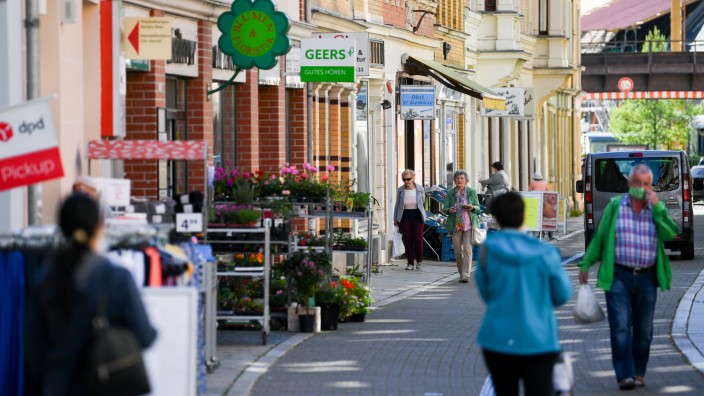Just don't panic
Corona new infectionsJust don't panic

The district of Greiz in Thuringia - a nationwide focus of new corona evidence.
(Photo: ZB)Two counties exceed the permitted threshold for new infections. There you are relaxed - you know the herds of infection.
The mailboxes in the district office reveal a lot about what's going on in the Greiz district. "We are flooded with news that we are accused of total failure," says the district office. In the Thuringian district, 75 new infections with Covid-19 have been registered in the past seven days - as of May 8, midnight - calculated on 100,000 inhabitants. Nationwide, Greiz is far ahead in this statistic nationwide - and far above the threshold of 50 cases, from which stricter restrictions should apply again.
But one does not think of a return to the lockdown. "The district will not go into quarantine," said District Administrator Martina Schweinsburg (CDU). On the contrary, there will be easing next week.
The high number of cases is due to mass tests in six nursing homes, said Schweinsburg. Of the 855 tests conducted among residents and employees, 47 were positive. Outside the homes, only 18 new infections have been registered since May 1, the district said. Most of the cases also occurred in the southern district, almost none in the northern part. "We understand that people have questions and concerns," said a spokeswoman for the district office. But if you take a closer look, there is no reason to shut down public life in the entire circle.
"The Westphalian is calm and level-headed," says the district office
Throughout Germany, there was only one other group on Friday that exceeded the threshold of 50 new corona cases: Coesfeld in North Rhine-Westphalia with almost 66 new infections per 100,000 inhabitants. On Friday afternoon, NRW's Minister of Health Karl-Josef Laumann (CDU) announced that the easing planned in Monday's Coesfeld district would be postponed for a week. Similar to Greiz, the source of the infection is known and can be narrowed down: a large slaughterhouse. The plant is closed for the time being, the employees of all slaughterhouses in NRW are to be tested. On Thursday alone, positive tests with almost 90 employees were registered in Coesfeld. "The health department reacted quickly and consistently," said Dietrich Aden, spokesman for the district office. Around 200 tests were carried out on Thursday. This explains the high number of cases. "We could also have said that we hardly test to look good in the statistics," says Aden. "But that's not the point."
So far, it is not assumed that the outbreak will extend beyond the employees and their contact persons. "We coordinate further measures with the state government," says Aden. In any case, people would not panic. "The Westphalian is calm and level-headed."
The situation is similarly relaxed in the Steinburg district in Schleswig-Holstein. According to the Robert Koch Institute, the so-called seven-day incidence is 37; this is the technical term for the number of new infections reported in the past seven days, per 100,000 inhabitants. It is the third highest in Germany. According to the district office, 77 currently sick people work in a slaughterhouse. The contract workers, mostly Romanians, are in quarantine in their shared accommodation.
There are regular health checks and corona tests for the residents, reports the district office. Neither in the village of Kellinghusen, where the victims are housed, nor anywhere else in the district is a widespread outbreak known. "We do not assume that we have to strictly cordon off everything," said Sonja Wilke, spokeswoman for the agency.
All reports on the current situation in Germany and worldwide as well as the most important news of the day - twice a day with SZ Espresso. Our newsletter brings you up to date in the morning and evening. Free registration: sz.de/espresso . In our news app ( download here ) you can also subscribe to the espresso or urgent messages as a push message .
Nobody wants to make predictions about the further course
On Friday evening, the Ministry of Health in Kiel ordered the workers of all slaughterhouses in Schleswig-Holstein to be tested. A total of 109 employees had tested positive in the slaughterhouse in Bad Bramstedt in the Steinburg neighboring district of Segeberg. In the Zollernalb district in Baden-Württemberg, serious thoughts are being taken about measures in the event that the situation worsens. On Friday, the district had 37 new infections per 100,000 inhabitants in seven days. Here, in contrast to the other badly affected areas, the contagions are widely distributed. What could partly explain the large number of registered cases: From the beginning, tests were above average, said District Administrator Günther-Martin Pauli (CDU). "We are continuing this strategy."
The situation changes every day. For precisely this reason, the threshold of 50 new infections in Rosenheim is not considered to be particularly meaningful. As early as Wednesday, the city had a value of just under 52 - on Friday the figure was just 22. The explanation: In Rosenheim, the cases had concentrated on three asylum seeker accommodations, says city spokesman Christian Schwalm. Most of the tests there were a week ago, so that they no longer influence the statistics. Such fluctuations could occur more often, says Schwalm, especially if there are individual, severely affected foci of infection. "But it makes little sense to seal everything off on a day with a value above 50 and unlock it the next day when the number has decreased," he says.


No comments
Please do not enter any spam link in this comment box.